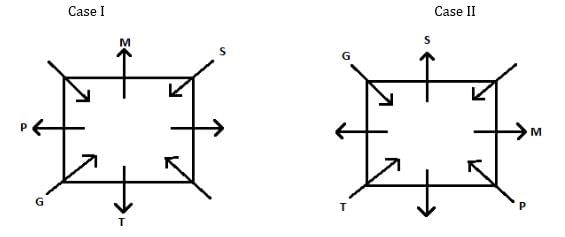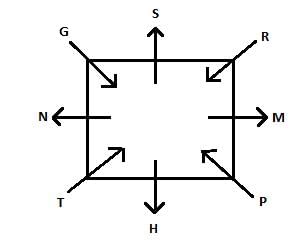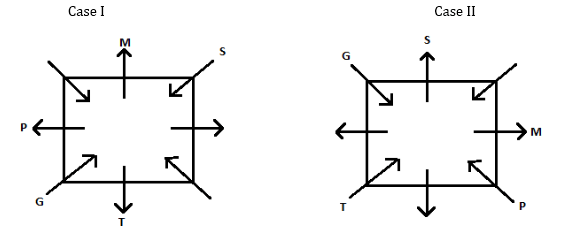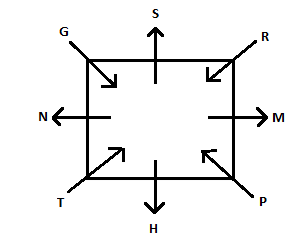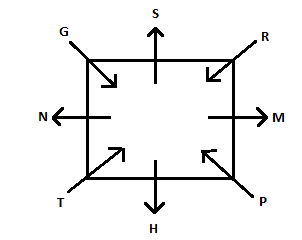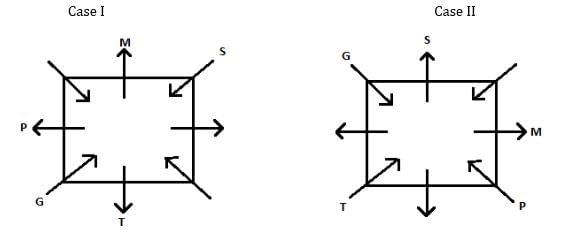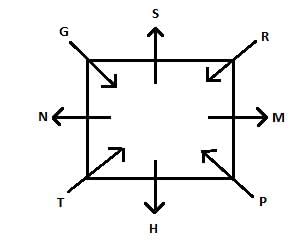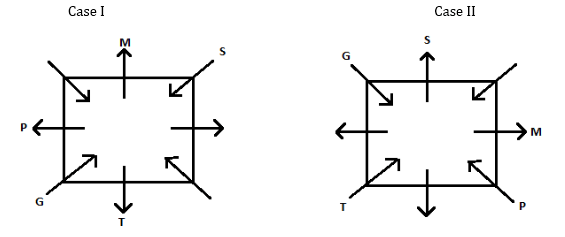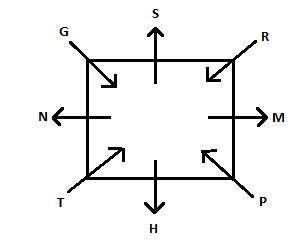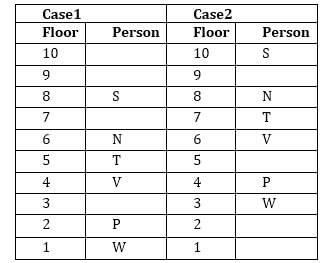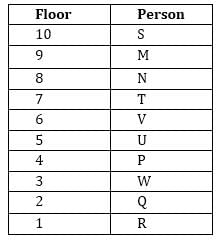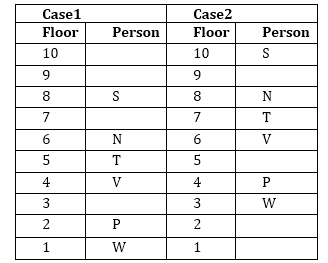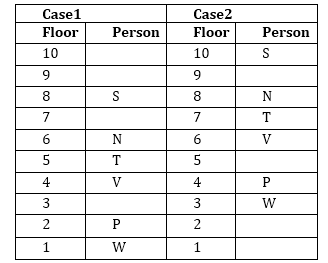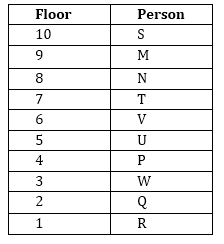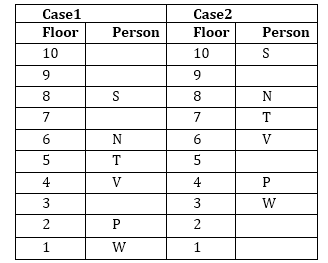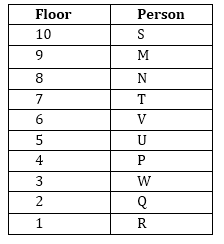NIACL Mock Test - 6 - Insurance MCQ
30 Questions MCQ Test - NIACL Mock Test - 6
In each of the question, relationships between some elements are shown in the statements. These statements are followed by conclusions numbered I and II. Read the statements and give the answer.
Statements:
C ≤ D ≤ J = O ≥ P ≥ R ≤ S
Conclusions:
I. O ≥ C
II. R ≥ J
C ≤ D ≤ J = O ≥ P ≥ R ≤ S
Conclusions:
I. O ≥ C
II. R ≥ J
In each of the question, relationships between some elements are shown in the statements. These statements are followed by conclusions numbered I and II. Read the statements and give the answer.
Statements:
Z ≥ Y > X ≥ U ≥ V = W < T
Conclusions:
I. W < Y
II. T > V
Z ≥ Y > X ≥ U ≥ V = W < T
Conclusions:
I. W < Y
II. T > V
In each of the question, relationships between some elements are shown in the statements. These statements are followed by conclusions numbered I and II. Read the statements and give the answer.
Statements:
M= N ≥ P ≥ O = R ≤ S < Q
Conclusions:
I. O > Q
II. R ≤ M
M= N ≥ P ≥ O = R ≤ S < Q
Conclusions:
I. O > Q
II. R ≤ M
In each of the question, relationships between some elements are shown in the statements. These statements are followed by conclusions numbered I and II. Read the statements and give the answer.
Statements:
H > G = F ≥ S ≥ R = T ≥ M
Conclusions:
I. R < F
II. G = R
In each of the question, relationships between some elements are shown in the statements. These statements are followed by conclusions numbered I and II. Read the statements and give the answer.
Statements:
P < T = S ≤ D = F > G ≥ J
Conclusions:
I. G < T
II. P > F
Study the following information carefully and answer the given questions:
Eight friends G, H, M, N, P, R, S and T are sitting around a square table in such a way that four of them sit at four corners of the square while the other four sit in the middle of each sides. The ones who sit at the four corners face towards the centre while those who sit in the middle of the sides face outside.
P sits second to the right of T. The number of people sits between S and P when counted from
left of P is same to the number of persons sit between T and S when counted from right of S. G,
who faces inside sits third to the left of M. M does not sit opposite to P or S. R does not face
outside. N sits second to the right of H. S is not an immediate neighbor of T.
Q. Who sits exactly between M and S, when counted from the right of M?
Study the following information carefully and answer the given questions:
Eight friends G, H, M, N, P, R, S and T are sitting around a square table in such a way that four of them sit at four corners of the square while the other four sit in the middle of each sides. The ones who sit at the four corners face towards the centre while those who sit in the middle of the sides face outside.
P sits second to the right of T. The number of people sits between S and P when counted from
left of P is same to the number of persons sit between T and S when counted from right of S. G,
who faces inside sits third to the left of M. M does not sit opposite to P or S. R does not face
outside. N sits second to the right of H. S is not an immediate neighbor of T.
Q. What is the position of T with respect to G?
Study the following information carefully and answer the given questions:
Eight friends G, H, M, N, P, R, S and T are sitting around a square table in such a way that four of them sit at four corners of the square while the other four sit in the middle of each sides. The ones who sit at the four corners face towards the centre while those who sit in the middle of the sides face outside.
P sits second to the right of T. The number of people sits between S and P when counted from
left of P is same to the number of persons sit between T and S when counted from right of S. G,
who faces inside sits third to the left of M. M does not sit opposite to P or S. R does not face
outside. N sits second to the right of H. S is not an immediate neighbor of T.
Q. Four of the following five are alike in a certain way and so form a group. Who among the following does not belong to that group?
Study the following information carefully and answer the given questions:
Eight friends G, H, M, N, P, R, S and T are sitting around a square table in such a way that four of them sit at four corners of the square while the other four sit in the middle of each sides. The ones who sit at the four corners face towards the centre while those who sit in the middle of the sides face outside.
P sits second to the right of T. The number of people sits between S and P when counted from
left of P is same to the number of persons sit between T and S when counted from right of S. G,
who faces inside sits third to the left of M. M does not sit opposite to P or S. R does not face
outside. N sits second to the right of H. S is not an immediate neighbor of T.
Q. Who sits second to the right of P?
Study the following information carefully and answer the given questions:
Eight friends G, H, M, N, P, R, S and T are sitting around a square table in such a way that four of them sit at four corners of the square while the other four sit in the middle of each sides. The ones who sit at the four corners face towards the centre while those who sit in the middle of the sides face outside.
P sits second to the right of T. The number of people sits between S and P when counted from
left of P is same to the number of persons sit between T and S when counted from right of S. G,
who faces inside sits third to the left of M. M does not sit opposite to P or S. R does not face
outside. N sits second to the right of H. S is not an immediate neighbor of T.
Q. If all the persons are arranged as per the alphabetical order starting from G (in the clockwise direction from G), then the position of how many persons will remain unchanged (except G)?
These questions are based on the following set of numbers.
327 654 978 721 198
Q. If all the digits in each number are arranged in ascending order within the number, then which of the following will form the third highest in the new arrangement?
These questions are based on the following set of numbers.
327 654 978 721 198
Q. If all the digits in each number are reversed within the number itself, then which of the following will form the second highest in the new arrangement?
These questions are based on the following set of numbers.
327 654 978 721 198
Q. What will be the difference between the second digit of the highest number and third digit of the second lowest number?
These questions are based on the following set of numbers.
327 654 978 721 198
Q. If ‘2’ is added to all the given numbers, then the resultant of how many numbers will be divisible by 7?
These questions are based on the following set of numbers.
327 654 978 721 198
Q. What will be the difference of the twice of lowest number and half of the highest number?
Study the information and answer the following questions:
Ten persons A, B, C, D, E, F, G, H, J and K are sitting in a row some are facing north and some are facing south (but not necessarily in the same manner).
(Note: Facing the same direction means if one is facing north then the other also faces north and vice versa. Facing opposite direction means if one is facing north then the other faces south and vice versa).
A sits fourth to the left of E, who faces north. G sits to the immediate right of E. Two persons sit between G and H. K sits third to the right of H. H does not sit to the right of E. Two persons sit between K and C. D sits second to the left of C. J sits to the immediate left of D. F sits fourth to the right of J. B faces north. A and F faces same direction as J. K faces opposite direction of B. Persons sitting at the extreme ends faces same direction.
Q. Who among the following sits to the immediate right of B?
Study the information and answer the following questions:
Ten persons A, B, C, D, E, F, G, H, J and K are sitting in a row some are facing north and some are facing south (but not necessarily in the same manner).
(Note: Facing the same direction means if one is facing north then the other also faces north and vice versa. Facing opposite direction means if one is facing north then the other faces south and vice versa).
A sits fourth to the left of E, who faces north. G sits to the immediate right of E. Two persons sit between G and H. K sits third to the right of H. H does not sit to the right of E. Two persons sit between K and C. D sits second to the left of C. J sits to the immediate left of D. F sits fourth to the right of J. B faces north. A and F faces same direction as J. K faces opposite direction of B. Persons sitting at the extreme ends faces same direction.
Q. How many persons sit between F and G?
Study the information and answer the following questions:
Ten persons A, B, C, D, E, F, G, H, J and K are sitting in a row some are facing north and some are facing south (but not necessarily in the same manner).
(Note: Facing the same direction means if one is facing north then the other also faces north and vice versa. Facing opposite direction means if one is facing north then the other faces south and vice versa).
A sits fourth to the left of E, who faces north. G sits to the immediate right of E. Two persons sit between G and H. K sits third to the right of H. H does not sit to the right of E. Two persons sit between K and C. D sits second to the left of C. J sits to the immediate left of D. F sits fourth to the right of J. B faces north. A and F faces same direction as J. K faces opposite direction of B. Persons sitting at the extreme ends faces same direction.
Q. What is the position of F with respect to K?
Study the information and answer the following questions:
Ten persons A, B, C, D, E, F, G, H, J and K are sitting in a row some are facing north and some are facing south (but not necessarily in the same manner).
(Note: Facing the same direction means if one is facing north then the other also faces north and vice versa. Facing opposite direction means if one is facing north then the other faces south and vice versa).
A sits fourth to the left of E, who faces north. G sits to the immediate right of E. Two persons sit between G and H. K sits third to the right of H. H does not sit to the right of E. Two persons sit between K and C. D sits second to the left of C. J sits to the immediate left of D. F sits fourth to the right of J. B faces north. A and F faces same direction as J. K faces opposite direction of B. Persons sitting at the extreme ends faces same direction.
Q. Who among the following sits at the extreme end of the row?
Study the information and answer the following questions:
Ten persons A, B, C, D, E, F, G, H, J and K are sitting in a row some are facing north and some are facing south (but not necessarily in the same manner).
(Note: Facing the same direction means if one is facing north then the other also faces north and vice versa. Facing opposite direction means if one is facing north then the other faces south and vice versa).
A sits fourth to the left of E, who faces north. G sits to the immediate right of E. Two persons sit between G and H. K sits third to the right of H. H does not sit to the right of E. Two persons sit between K and C. D sits second to the left of C. J sits to the immediate left of D. F sits fourth to the right of J. B faces north. A and F faces same direction as J. K faces opposite direction of B. Persons sitting at the extreme ends faces same direction.
Q. How many persons face south?
Study the following sequence and answer the given questions.
E @ 1 R T # 3 A D 5 & G 8 L U J 9 ~ W $ K 4 2 I 7 % C Z O 6 P
Q. Which of the following element is 7th to the right of the one which is 27th from the right end of the given arrangement?
Study the following sequence and answer the given questions.
E @ 1 R T # 3 A D 5 & G 8 L U J 9 ~ W $ K 4 2 I 7 % C Z O 6 P
Q. If all the alphabets are dropped from the series, which element will be fifth to the left of the one which is twelfth from the left end of the new arrangement?
Study the following sequence and answer the given questions.
E @ 1 R T # 3 A D 5 & G 8 L U J 9 ~ W $ K 4 2 I 7 % C Z O 6 P
Q. How many such digits are there in the given series which are immediately preceded by a vowel but not immediately followed by a symbol?
Study the following sequence and answer the given questions.
E @ 1 R T # 3 A D 5 & G 8 L U J 9 ~ W $ K 4 2 I 7 % C Z O 6 P
Q. How many such consonants are there in the given series which are immediately preceded by a number and immediately followed by an alphabet?
Study the following sequence and answer the given questions.
E @ 1 R T # 3 A D 5 & G 8 L U J 9 ~ W $ K 4 2 I 7 % C Z O 6 P
Q. What should come in place of question mark (?) in the following series based on the above arrangement?
6CO 74I $9W UGL?
Study the following information carefully and answer the question given below-
Ten people viz. M, N, P, Q, R, S, T, U, V and W live in a building of ten different floors. The ground floor is numbered as 1, the floor just above it is numbered as 2 and so on till top floor which is numbered as 10 (but not necessarily in the same order).
N lives on an even numbered floor above floor number 5 but not on top floor. Four persons live between N and W. P lives immediately above W. Two persons live between P and T. V lives immediately below T. One person live between S and N. Three persons live between M and U. Q lives immediately above R but not on top floor. M lives above N.
Q. Who among the following lives on ground floor?
Study the following information carefully and answer the question given below-
Ten people viz. M, N, P, Q, R, S, T, U, V and W live in a building of ten different floors. The ground floor is numbered as 1, the floor just above it is numbered as 2 and so on till top floor which is numbered as 10 (but not necessarily in the same order).
N lives on an even numbered floor above floor number 5 but not on top floor. Four persons live between N and W. P lives immediately above W. Two persons live between P and T. V lives immediately below T. One person live between S and N. Three persons live between M and U. Q lives immediately above R but not on top floor. M lives above N.
Q. Who among the following lives immediately below W?
Study the following information carefully and answer the question given below-
Ten people viz. M, N, P, Q, R, S, T, U, V and W live in a building of ten different floors. The ground floor is numbered as 1, the floor just above it is numbered as 2 and so on till top floor which is numbered as 10 (but not necessarily in the same order).
N lives on an even numbered floor above floor number 5 but not on top floor. Four persons live between N and W. P lives immediately above W. Two persons live between P and T. V lives immediately below T. One person live between S and N. Three persons live between M and U. Q lives immediately above R but not on top floor. M lives above N.
Q. How many persons live above T?
Study the following information carefully and answer the question given below-
Ten people viz. M, N, P, Q, R, S, T, U, V and W live in a building of ten different floors. The ground floor is numbered as 1, the floor just above it is numbered as 2 and so on till top floor which is numbered as 10 (but not necessarily in the same order).
N lives on an even numbered floor above floor number 5 but not on top floor. Four persons live between N and W. P lives immediately above W. Two persons live between P and T. V lives immediately below T. One person live between S and N. Three persons live between M and U. Q lives immediately above R but not on top floor. M lives above N.
Q. Four of the following five are alike in a certain way and hence form a group. Who among the following does not belong to that group?
Study the following information carefully and answer the question given below-
Ten people viz. M, N, P, Q, R, S, T, U, V and W live in a building of ten different floors. The ground floor is numbered as 1, the floor just above it is numbered as 2 and so on till top floor which is numbered as 10 (but not necessarily in the same order).
N lives on an even numbered floor above floor number 5 but not on top floor. Four persons live between N and W. P lives immediately above W. Two persons live between P and T. V lives immediately below T. One person live between S and N. Three persons live between M and U. Q lives immediately above R but not on top floor. M lives above N.
Q. Who among the following lives on floor number 7?








